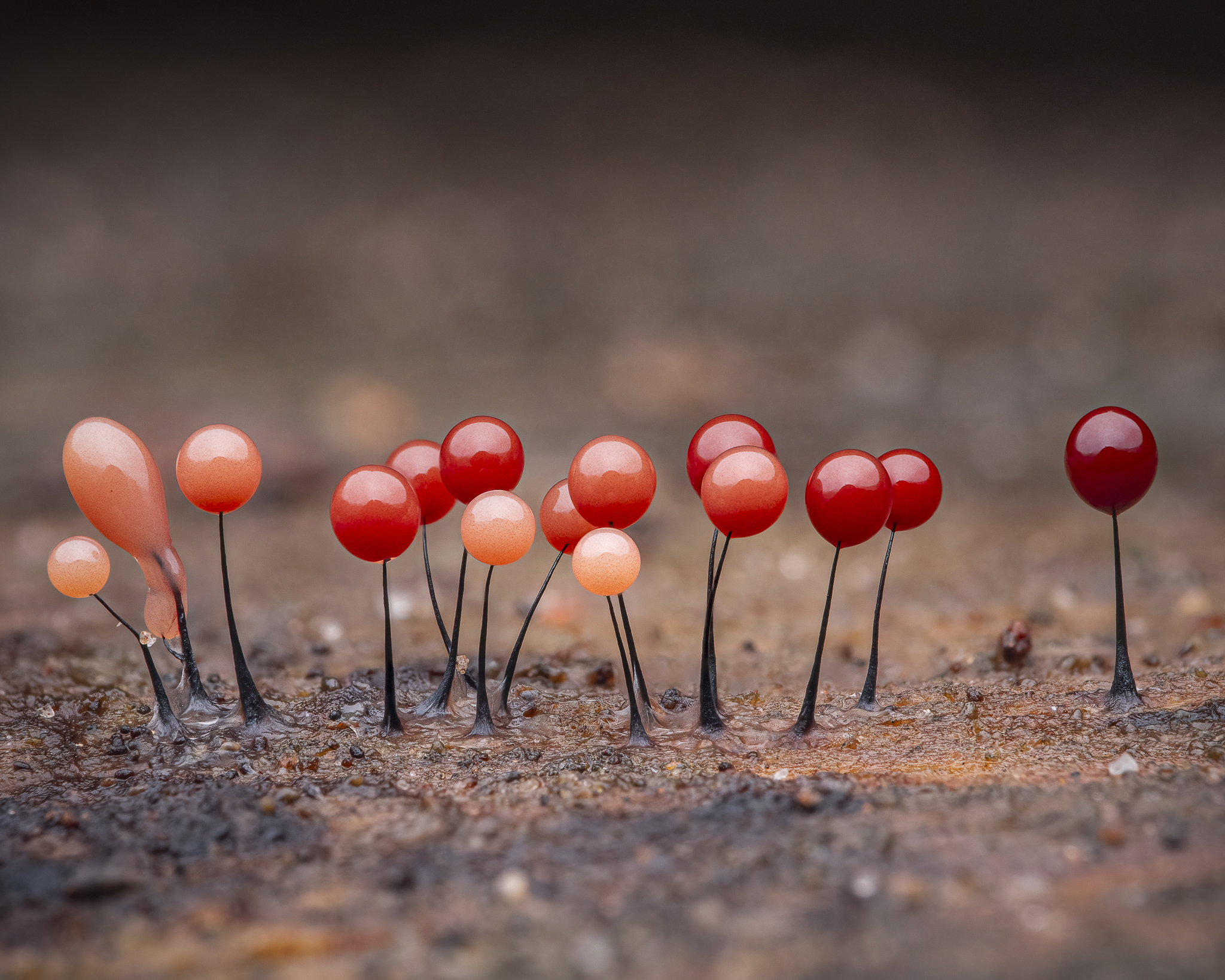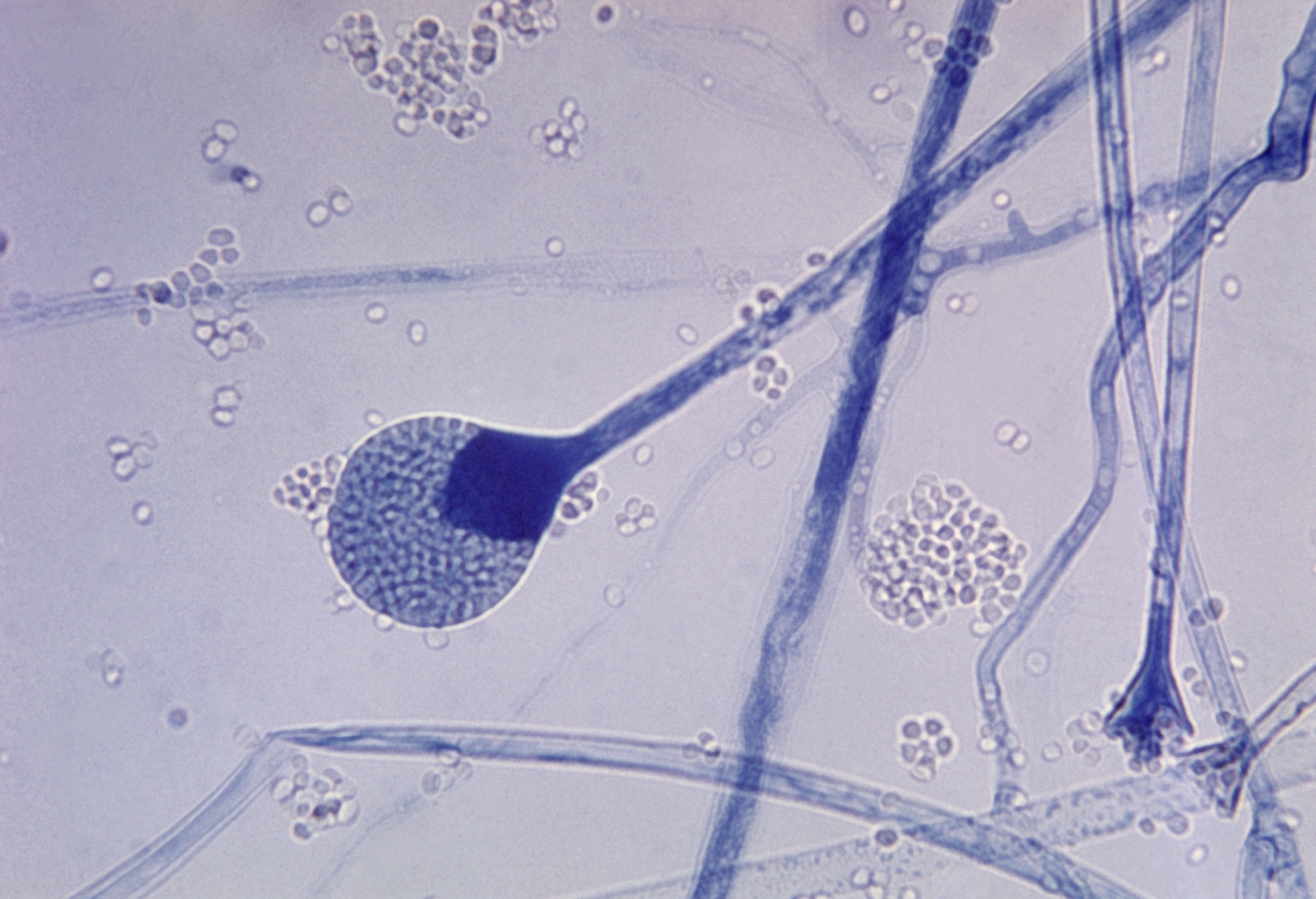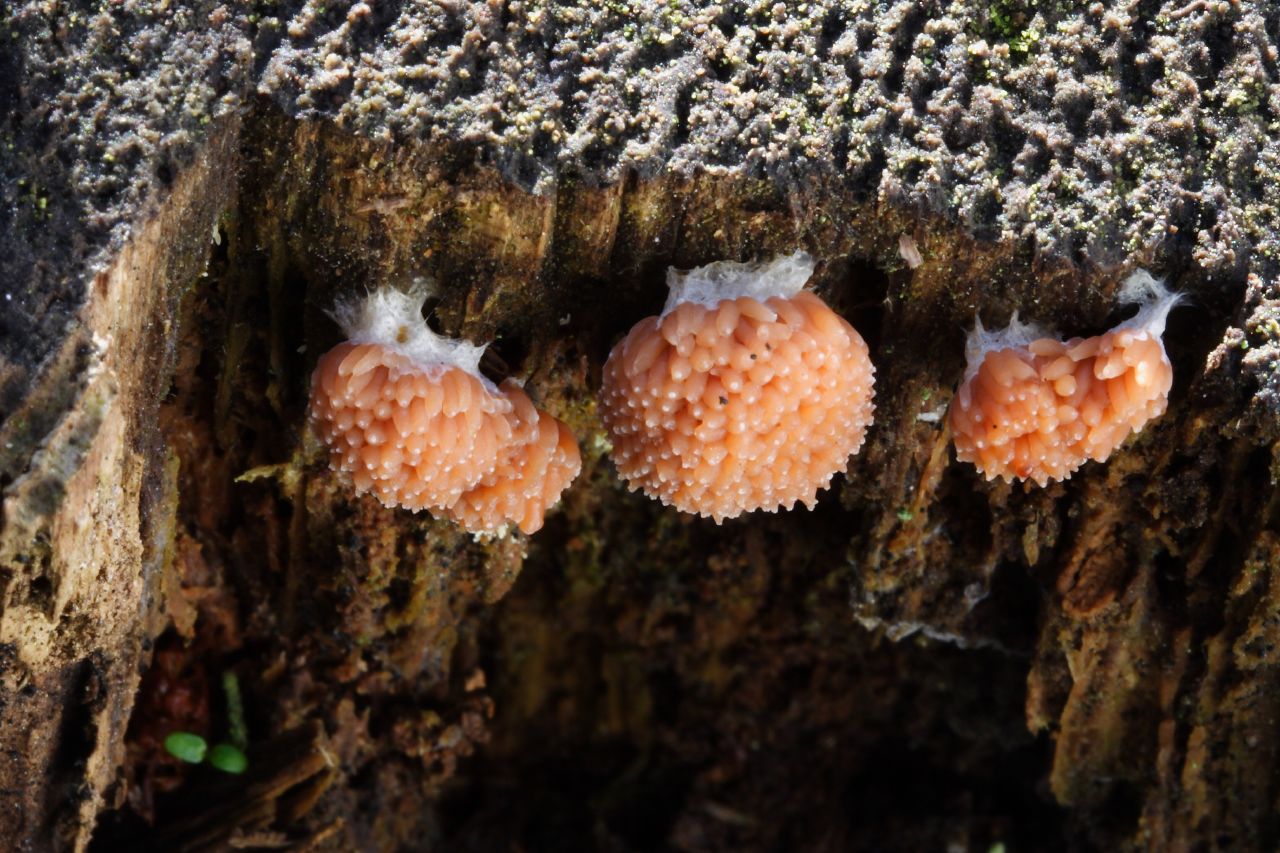|
Tubifera Ferruginosa
''Tubifera ferruginosa'', more commonly known as ''raspberry slime mold'' or ''red raspberry slime mold'', is a species of slime mold in the class Myxogastria. It is one of the most widely known and distinct slime molds, being found throughout temperate regions of the world, primarily in Europe and North America. Description ''T. ferruginosa'' is often found growing on damp rotten wood in temperate forests. It forms small, cushion-like "pseudoaethalia", or fruiting bodies from June to November that are bright red when young, and purple-brown when mature. These "pseudoaethalia" are different from the aethelia of other slime molds like Fuligo septica, because they are made of tightly bunched, gelatinous rods, or sporangia A sporangium (from Late Latin, ; : sporangia) is an enclosure in which spores are formed. It can be composed of a unicellular organism, single cell or can be multicellular organism, multicellular. Virtually all plants, fungus, fungi, and many ot .... Each in ... [...More Info...] [...Related Items...] OR: [Wikipedia] [Google] [Baidu] |
August Batsch
August Johann Georg Karl Batsch (28 October 1761 – 29 September 1802) was a German naturalist. He was a recognised authority on mushrooms, and also described new species of ferns, bryophytes, and seed plants. Life and career Batsch was born in Jena, Saxe-Weimar to George Lorenz Bratsch and Ernestine (''nee'' Franke) Bratsch. He studied at the Jena City School, and then had private tuition. He showed an aptitude for natural sciences and drawing, and so subsequently studied medicine and philosophy at the University of Jena (now known as the Friedrich Schiller University of Jena), entering in 1772 and obtaining his doctorate in philosophy in 1781 and in medicine in 1786, his supervisor being Justus Christian Loder. Batsch was married in 1787 to Amalie Pfaundel. They had three children, Friedrich (born 1789), George Friedrich Karl (1792), and Karoline (1795). He died in 1802 after a short illness. In 1786 Batsch began to teach natural history at the University of Jena and in ... [...More Info...] [...Related Items...] OR: [Wikipedia] [Google] [Baidu] |
Slime Mold
Slime mold or slime mould is an informal name given to a polyphyletic assemblage of unrelated eukaryotic organisms in the Stramenopiles, Rhizaria, Discoba, Amoebozoa and Holomycota clades. Most are near-microscopic; those in the Myxogastria form larger plasmodial slime molds visible to the naked eye. The slime mold life cycle includes a free-living single-celled stage and the formation of spores. Spores are often produced in macroscopic multicellular or multinucleate fruiting bodies that may be formed through aggregation or fusion; aggregation is driven by chemical signals called acrasins. Slime molds contribute to the decomposition of dead vegetation; some are parasitic. Most slime molds are terrestrial and free-living, typically in damp shady habitats such as in or on the surface of rotting wood. Some myxogastrians and protostelians are aquatic or semi-aquatic. The phytomyxea are parasitic, living inside their plant hosts. Geographically, slime molds are cosmopo ... [...More Info...] [...Related Items...] OR: [Wikipedia] [Google] [Baidu] |
Class (biology)
In biological classification, class () is a taxonomic rank, as well as a taxonomic unit, a taxon, in that rank. It is a group of related taxonomic orders. Other well-known ranks in descending order of size are domain, kingdom, phylum, order, family, genus, and species, with class ranking between phylum and order. History The class as a distinct rank of biological classification having its own distinctive name – and not just called a ''top-level genus'' ''(genus summum)'' – was first introduced by French botanist Joseph Pitton de Tournefort in the classification of plants that appeared in his '' Eléments de botanique'' of 1694. Insofar as a general definition of a class is available, it has historically been conceived as embracing taxa that combine a distinct ''grade'' of organization—i.e. a 'level of complexity', measured in terms of how differentiated their organ systems are into distinct regions or sub-organs—with a distinct ''type'' of construction, whic ... [...More Info...] [...Related Items...] OR: [Wikipedia] [Google] [Baidu] |
Myxogastria
Myxogastria/Myxogastrea (myxogastrids, ICZN) or Myxomycetes ( ICN) is a class of slime molds that contains 5 orders, 14 families, 62 genera, and 888 species. They are colloquially known as the ''plasmodial'' or ''acellular'' slime moulds. All species pass through several very different morphologic phases, such as microscopic individual cells, slimy amorphous organisms visible with the naked eye, and conspicuously shaped fruit bodies. Although they are monocellular, they can reach immense widths and weights: in extreme cases they can be up to across and weigh up to . The class Myxogastria is distributed worldwide, but it is more common in temperate regions where it has a higher biodiversity than in polar regions, the subtropics, or the tropics. They are mainly found in open forests, but also in extreme regions such as deserts, under snow blankets, or underwater. They also occur on the bark of trees, sometimes high in the canopy. These are known as cort ... [...More Info...] [...Related Items...] OR: [Wikipedia] [Google] [Baidu] |
Temperate Climate
In geography, the temperate climates of Earth occur in the middle latitudes (approximately 23.5° to 66.5° N/S of the Equator), which span between the tropics and the polar regions of Earth. These zones generally have wider temperature ranges throughout the year and more distinct seasonal changes compared to tropical climates, where such variations are often small; they usually differ only in the amount of precipitation. In temperate climates, not only do latitudinal positions influence temperature changes, but various sea currents, prevailing wind direction, continentality (how large a landmass is) and altitude also shape temperate climates. The Köppen climate classification defines a climate as "temperate" C, when the mean temperature is above but below in the coldest month to account for the persistence of frost. However, some adaptations of Köppen set the minimum at . Continental climates are classified as D and considered to be varieties of temperate climates, ... [...More Info...] [...Related Items...] OR: [Wikipedia] [Google] [Baidu] |
Europe
Europe is a continent located entirely in the Northern Hemisphere and mostly in the Eastern Hemisphere. It is bordered by the Arctic Ocean to the north, the Atlantic Ocean to the west, the Mediterranean Sea to the south, and Asia to the east. Europe shares the landmass of Eurasia with Asia, and of Afro-Eurasia with both Africa and Asia. Europe is commonly considered to be Boundaries between the continents#Asia and Europe, separated from Asia by the Drainage divide, watershed of the Ural Mountains, the Ural (river), Ural River, the Caspian Sea, the Greater Caucasus, the Black Sea, and the waterway of the Bosporus, Bosporus Strait. "Europe" (pp. 68–69); "Asia" (pp. 90–91): "A commonly accepted division between Asia and Europe ... is formed by the Ural Mountains, Ural River, Caspian Sea, Caucasus Mountains, and the Black Sea with its outlets, the Bosporus and Dardanelles." Europe covers approx. , or 2% of Earth#Surface, Earth's surface (6.8% of Earth's land area), making it ... [...More Info...] [...Related Items...] OR: [Wikipedia] [Google] [Baidu] |
North America
North America is a continent in the Northern Hemisphere, Northern and Western Hemisphere, Western hemispheres. North America is bordered to the north by the Arctic Ocean, to the east by the Atlantic Ocean, to the southeast by South America and the Caribbean Sea, and to the south and west by the Pacific Ocean. The region includes Middle America (Americas), Middle America (comprising the Caribbean, Central America, and Mexico) and Northern America. North America covers an area of about , representing approximately 16.5% of Earth's land area and 4.8% of its total surface area. It is the third-largest continent by size after Asia and Africa, and the list of continents and continental subregions by population, fourth-largest continent by population after Asia, Africa, and Europe. , North America's population was estimated as over 592 million people in list of sovereign states and dependent territories in North America, 23 independent states, or about 7.5% of the world's popula ... [...More Info...] [...Related Items...] OR: [Wikipedia] [Google] [Baidu] |
Fuligo Septica
''Fuligo septica'' is a species of slime mold in the class Myxogastria, Myxomycetes. It is common name, commonly known as scrambled egg slime or flowers of tan because of its peculiar yellowish appearance; it is also known as dog vomit slime mold. This slime mold is relatively common with a worldwide distribution, often being found on bark, mulch, lawns, as well as other rotting organic matter in urban areas after heavy rain or excessive watering. Their spores are produced on or in aerial sporangia and are spread by wind. History and taxonomy The first description of the species was provided by French botanist Jean Marchant in 1727, who referred to it as "''fleur de tan''" (bark flower); Marchant also classified it as "''des éponges''" (one of the sponges). Carl Linnaeus called it ''Mucor septicus'' in his 1763 ''Species Plantarum''. The species was transferred to the genus ''Fuligo'' by German botanist Friedrich Heinrich Wiggers in 1780. Description and habitat Like many slime ... [...More Info...] [...Related Items...] OR: [Wikipedia] [Google] [Baidu] |
Sporangium
A sporangium (from Late Latin, ; : sporangia) is an enclosure in which spores are formed. It can be composed of a unicellular organism, single cell or can be multicellular organism, multicellular. Virtually all plants, fungus, fungi, and many other groups form sporangia at some point in their biological life cycle, life cycle. Sporangia can produce spores by mitosis, but in land plants and many fungi, sporangia produce genetically distinct haploid spores by meiosis. It's outdated name, sporange, is one of the few perfect rhymes for Orange (colour), orange. Fungi In some phyla of fungi, the sporangium plays a role in asexual reproduction, and may play an indirect role in sexual reproduction. The sporangium forms on the sporangiophore and contains Ploidy, haploid Cell nucleus, nuclei and cytoplasm. Spores are formed in the sporangiophore by encasing each haploid nucleus and cytoplasm in a tough outer membrane. During asexual reproduction, these spores are dispersed via wind and g ... [...More Info...] [...Related Items...] OR: [Wikipedia] [Google] [Baidu] |
Hypothallus
In true slime molds (myxogastria), lichens, and in species of the family Clavicipitaceae, the hypothallus is the layer on which the fruit body sits, lying in contact with the substrate. The word is derived from the Ancient Greek root ''hypó'' ("under") and ''thallós'' ("shoot" or "thallus"). The hypothallus is produced by the plasmodium at the beginning of fructification. Depending on the species, it can be membranous to thick or tender to solid and nearly transparent to brightly coloured. It may surround an individual fruit body, or may form a contiguous connection between multiple fruit bodies. In some rare cases it is missing entirely. In crustose lichens, the hypothallus is the blackish lower layer of the thallus that produces rhizines, which are holdfasts that attach the lichen to its substrate. In some taxa the hypothallus may be involved in the formation of the fruit body. In the "epihypothallic" Stemonitida, the hypothallus forms hollow, tubular stems and a columella, ... [...More Info...] [...Related Items...] OR: [Wikipedia] [Google] [Baidu] |
Tubifera Ferruginosa 52288
''Tubifera'' is a genus of slime moulds from the subclass Myxogastria. The genus comprises 12 species. Description The fruit-bodies are aethalia formed from numerous, usually densely packed sporangia. The oblong sporangia are ochre, pink or red to dark brown and may be shiny or shimmering. They open at the tip to release the spores. The hypothallus is spongy, occasionally raised to a stem-like, stock, dark-coloured structure or also, on ''Tubifera bombarda'', soft and film-like thin. The membranous, single layered peridium outlasts the below half. A pseudocapillitium may or may not be present. The spores are light yellow to reddish-brown. Habitat ''Tubifera ferruginosa'' and ''Tubifera microsperma'' are more widespread and common than the other species from this genus. All species, except ''Tubifera casparyii'', are also common in the tropics. Classification The genus was circumscribed in 1873 by Józef Thomasz Rostafiński. The type species is ''Tubifera ferruginosa'', fi ... [...More Info...] [...Related Items...] OR: [Wikipedia] [Google] [Baidu] |
Protists Described In 1791
A protist ( ) or protoctist is any Eukaryote, eukaryotic organism that is not an animal, Embryophyte, land plant, or fungus. Protists do not form a Clade, natural group, or clade, but are a Paraphyly, paraphyletic grouping of all descendants of the last eukaryotic common ancestor excluding land plants, animals, and fungi. Protists were historically regarded as a separate taxonomic rank, taxonomic kingdom (biology), kingdom known as Protista or Protoctista. With the advent of phylogenetic analysis and electron microscopy studies, the use of Protista as a formal taxon was gradually abandoned. In modern classifications, protists are spread across several eukaryotic clades called supergroup (biology), supergroups, such as Archaeplastida (photoautotrophs that includes land plants), SAR supergroup, SAR, Obazoa (which includes fungi and animals), Amoebozoa and "Excavata". Protists represent an extremely large genetic diversity, genetic and ecological diversity in all environments, in ... [...More Info...] [...Related Items...] OR: [Wikipedia] [Google] [Baidu] |







